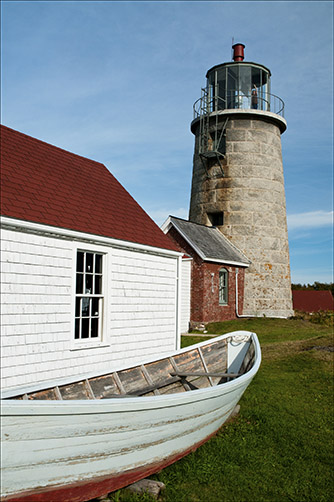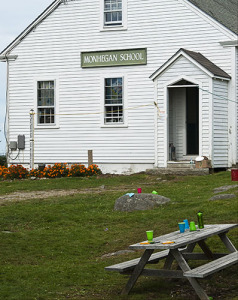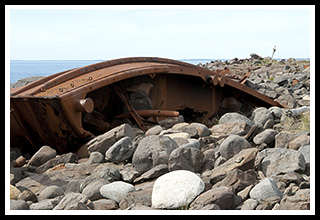Lighthouse Keeper Remembers Life on Monhegan Island in the 1950s, in Maine
Sometimes, opportunities are presented in life, or we follow our gut feelings, and things come together. A few years ago, I was at a family gathering and was excited about writing my book “New England Lighthouses: Famous Shipwrecks, Rescues, and Other Tales” consisting of lighthouse stories, when my brother-in-law, who happens to live a couple of hours away in New Hampshire’s White Mountains, approached me and told me that he had an employee whose father was one of the last surviving lighthouse keepers in New England, Paul Baptiste. Even more astounding, he lived with his wife Helen about an hour down the New Hampshire coast from where I live. I wondered, “What are the odds of this situation?” I was excited to be invited to this extraordinary person’s home with his wife and talk with some of his children. Paul Baptiste, who passed away recently after his wife, was one of the few remaining lighthouse keepers of his era and lived into his late eighties. He and Helen lived in various lighthouses and lifesaving stations with their family throughout New England’s states from the late 1940s through the 1950s.
In 1951, Paul was stationed as keeper for Baker’s Island Lighthouse in Boston Harbor with Helen and their five children. Although they loved life on Baker’s Island, they decided to look for a lighthouse area with a schoolhouse nearby for their growing family. A keeper at Maine’s Monhegan Island lighthouse, with a one-room schoolhouse, had just decided to quit his position, and Paul asked for and received the new post.
Monhegan Island is located 11 miles from the Maine shore. Not knowing what to expect, the family packed up and headed up the quiet coastline to the end of one of Maine’s tranquil peninsulas and took a ferry from Port Clyde to the island. When they arrived, they found, unlike Baker’s Island Light, where only residents came there in the summer, a rather large, beautiful, isolated island where the islanders, primarily fishermen, lived year-round. The one-room schoolhouse still exists today.
Upon meeting the local islanders, they found the inhabitants were very resistant to any changes and were very particular about maintaining life on the island as it had been for many years. One week, Paul was given orders to paint the lighthouse lantern room red and the rails green. A few days after he completed preparing and painting the structure, an elderly islander told him he couldn’t paint the lighthouse any color but traditional black. Paul said he was only following orders as his commander told him to complete the task. A few days later, Paul’s commander left communication to paint the lantern and rails black. Apparently, the islander had some pull with the commander.
On Monhegan Island, the year-round islanders needed to conserve water as often as possible, leaving little water for showers. The stored water was used mainly for drinking, especially in winter. When the Baptiste family first arrived, one of the lobstermen said, “Don’t take showers all winter,” and explained the reasoning. The family spent the winter in their warmest clothes as New England’s cold and freezing weather descended on the island. They obliged their local neighbors and would wait until spring before they could take any showers. When the weather improved, Paul would work as a carpenter on the side to make some extra income. Although life was quite different in that they were among the islanders year-round, they became quite fond of their neighbors, who appreciated the new lighthouse family.
The family sincerely appreciated and respected the Maine lobstermen in the Monhegan region. There was one of the wealthiest lobster beds in the world, and by law, they were allowed to catch the special prizes from one minute after midnight on December 31 until midnight on June 30 each year. They were a tight group of hard workers who always watched for one another. They were unselfish in that if one lobsterman couldn’t go out due to severe illness, the other lobstermen would get the word out and would not go out as well or would share their catch. It was a strict code of honor that still endures today.
Paul’s daily duties at Monhegan Island Light involved tending to the incandescent oil and vapor light known as an IOV. He could stand inside the huge second-order Fresnel lens and polish the numerous glass prisms. He would fill up the oil tank and wind up the weights, which rotated on solid brass wheels that he had to replace routinely.
In the early 1950s, the island used kerosene for illumination without electricity. Paul had a generator at the lighthouse, which was only used to pump water to the building. He asked for permission to use the generator for electricity on the first floor of the keeper’s house. He completed the job, which cast a very bright light on the room. The locals saw this new, brighter illumination coming from the lighthouse keeper’s quarters and asked him what kind of light he was using. He replied that he was using a particular type of lamp.
In 1952, Paul, now using the generator for electricity, bought and installed the first TV on the island. He then installed an antenna on top of the roof, which annoyed some of his local neighbors. He pointed the antennae out towards the sea and was able to pick up stations from as far away as North Carolina. Some locals asked him what was on his roof as they probably felt it was disturbing the scenery. He told them he had a TV, and they responded in amazement, “You have a TV?” He became popular as many locals stopped in to see what was on the new black box.
The Baptiste’s kept their car parked by the keeper’s house at Marshall Point Light on the mainland at Port Clyde and were close to their families. They would have a willing replacement brought in to watch and tend Monhegan light, as they would take the ferry to Port Clyde to pick up supplies or visit. Sometimes, they would miss the ferry and enjoy an overnight stay at the keeper’s house at Marshall Point Light. Their favorite replacement would sometimes even call and say, “Hey, do you need to go to the mainland?” so he could go out and enjoy sightseeing at Monhegan. It was a win-win situation for all.
School life for the children in the one-room schoolhouse was quite different than most of us when we grew up. If the teacher didn’t feel like coming to class, he would close the school for the day. Sometimes, during recess, the children would go back and sit on a large flat rock, watch the waves along the shore, and sometimes get drenched during high tide. One of Paul and Helen’s eldest sons remembers playing with a young boy who would come to the island in the one-room schoolhouse in summer, play with them all over the island, and then return to his home in New York. That child, James Barstol, became the owner of the Monhegan Boat Line, which makes daily trips to Monhegan Island during the fair weather months and tourist season. The one-room schoolhouse was not only used to educate the children, it was also used to host dances for everyone.
Years before the Baptiste family arrived on Monhegan Island, the tugboat Sheridan got caught in a storm and washed up on the rocky beach. The tug wreck was one of the favorite places for all the kids to play. The tug is still wrecked on the shore today and is known as one of the many attractions on this beautiful rocky Island. Next to Monhegan Island is a tiny island called Manana Island that has housed a fog signal for many years. There was a long ramp leading down to the shore where the kids, during the winter months, would use the boating rail as a bobsled to sail down the steep incline onto the bottom.
Monhegan Island has been a community for artists for centuries and still is. Paul saw this dead tree near the bottom of the hill from the lighthouse and decided to cut it down. He brought two sons to help him as he succeeded in removing the annoying site from his lighthouse. The next day, two men approached him in tears. Fearing something was wrong, he asked why they were so upset. They replied that someone had cut down their tree. He responded he was the guilty person as they remarked that they had been spending many hours painting the dead tree as part of the scenery.
Their flying Santa friend, Edward Rowe Snow, would still attempt to drop packages at Monhegan Island during the holiday season. Most of the time, he missed his mark due to the lighthouse’s location, and the locals picked up the presents instead to bring to the family. They had also met a famous lighthouse keeper’s wife, Connie Small. They had a special appreciation for her as she was stationed on lighthouses on isolated tiny “rock islands” instead of their stations, where they had plenty of land to explore and play.
The Baptiste family stayed on Monhegan Island until 1953. Tourists would visit the island and the lighthouse from Memorial Day weekend until Columbus Day weekend, then most of the island would again belong to the islanders. Islanders called these people “day-trippers.” Many years later, one of the elder sons, now a middle-aged adult, returned to visit the lighthouse he had grown up in. He visited one of the few local stores when he heard one of the locals refer to him in a tired, negative tone as a “day-tripper.” Upon hearing the comment, the son decided to correct the elderly lobsterman in commenting that he was one of keeper Paul Baptiste’s sons who had grown up in the lighthouse. Upon hearing the news, the atmosphere quickly changed to a hero’s welcome, with everyone in the building welcoming him home.
A few years ago, Paul and Helen visited Portsmouth Harbor Lighthouse in New Hampshire with the Friends of Portsmouth Harbor Light. He was quoted as saying, “Those were the good old days. You’re living at home 24 hours a day, seven days a week, raising your family, taking care of the lighthouse,” Paul’s character embodies how we should view those who serve in the Coast Guard and all branches of our military today: the love of country and the unselfish duty of helping out their fellow man, and dedication to family. Thank you for your service. Helen, who also recently passed away, embodies the love and commitment of a woman for her husband and loving children. Both Paul and Helen always decided what was best for their family. My favorite example involves Paul and Helen’s choice to go to Baker’s Island lighthouse instead of having the opportunity to be at the prestigious Boston lighthouse because there was more land for the kids to play in, and it was fenced in for safety. They allowed me to take this unique photo of them enjoying each other’s company. Being allowed in their home to listen to their stories was a pleasure.
Thank you.
Exploring Monhegan Island and the Lighthouse
If you ever get a chance to visit this remote island, you’ll find that not much has changed since Paul Baptiste and his family lived there. There are no paved roads, and only a few cars owned by the inns are used. You’ll still find the tugboat shipwreck his kids played around, and as an artist community in the summer months, you’ll find all kinds of artwork at various homes. It’s like going to someone’s house to purchase their wares. The Monhegan Museum of Art and History, located inside the keeper’s building next to the lighthouse, displays all kinds of memorabilia, along with works by local artists for visitors to the island to enjoy.
Trails lead around the island, with cliffs towering 130 feet over the water’s edge. It’s breathtaking scenery. You can take boats out of Port Clyde daily, and there are trips out of Port Clyde to get to the island. The Monhegan Boat Line takes daily trips to the island in the summer, where you can be dropped off and picked up at the dock, and you can stay overnight in one of the inns on the island with some fantastic food.
Here are some of my favorite photos of Monhegan Island Light.
Enjoy,
Allan Wood
Books to Explore
The Rise and Demise of the Largest Sailing Ships: Stories of the Six and Seven-Masted Coal Schooners of New England. In the early 1900s, New England shipbuilders constructed the world’s largest sailing ships amid social and political reforms. These giants were the ten original six-masted coal schooners and one colossal seven-masted vessel, built to carry massive quantities of coal and building supplies and measured longer than a football field! This self-published book, balanced with plenty of color and vintage images, showcases the historical accounts that followed these mighty ships.
Available also from bookstores in paperback, hardcover, and as an eBook for all devices.

Book – Lighthouses and Coastal Attractions in Southern New England: Connecticut, Rhode Island, Massachusetts
Lighthouses and Coastal Attractions of Southern New England: Connecticut, Rhode Island, and Massachusetts. This 300-page book provides memorable human interest stories from each of the 92 lighthouses. You can explore plenty of indoor and outdoor coastal attractions, including whale-watching excursions, lighthouse tours, windjammer sailing tours, parks, museums, and even lighthouses where you can stay overnight. You’ll also find plenty of stories of hauntings around lighthouses.
Lighthouses and Coastal Attractions of Northern New England: New Hampshire, Maine, and Vermont. This 300-page book provides memorable human interest stories from each of the 76 lighthouses. It also describes and provides contact info for plenty of indoor and outdoor coastal attractions and tours. These include whale watching, lighthouse tours, unique parks, museums, and lighthouses where you can stay overnight. There are also stories of haunted lighthouses in these regions.
New England Lighthouses: Famous Shipwrecks, Rescues & Other Tales contains over 50 stories, including the story of Paul Baptiste and his family life mentioned above. This image-rich book also contains vintage images provided by the Coast Guard and various organizations and paintings by six famous Coast Guard artists.
You can purchase this book and the lighthouse tourism books from the publisher Schiffer Books or in many fine bookstores such as Barnes and Noble.
Copyright © Allan Wood Photography; do not reproduce without permission. All rights reserved.
Join, Learn, and Support The American Lighthouse Foundation














